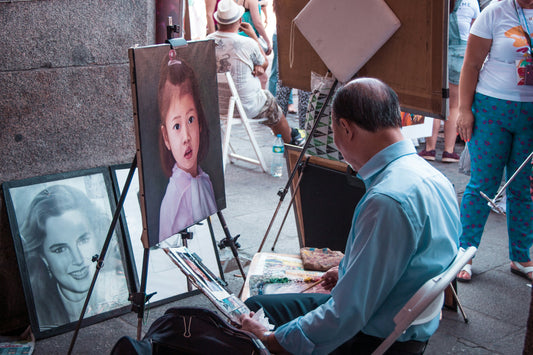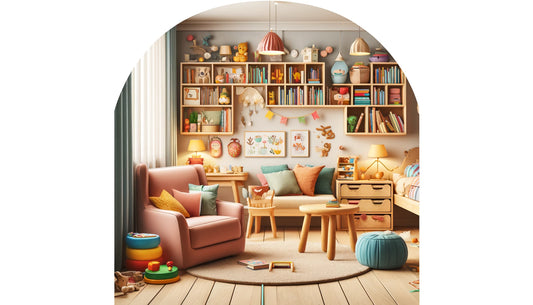Painting is a truly undervalued way for children to express themselves and have fun. It can also be an amazing way to explore the different elements of art and to gain skills that will help them to stretch their creative and conceptual thinking more vividly. With the right materials like paint brushes and palettes and a splash of imagination, your children can create works of art they’ll be proud of. Topics covered in this article include:
- Basic painting ideas for kids
- Materials needed for painting
- Safety tips for kids painting
- Making a paint station for kids
- Age appropriate painting ideas
- Tips for engaging kids in the painting process
- Sample painting projects for kids
- Benefits of painting for children's development.
Creative Painting Projects
For younger kids, you can choose a project that will capture their attention and allow them to explore their creative side. You can use basic shapes such as circles, squares, triangles, and stars to create a fun and colourful painting. If you have older kids, they may even be able to come up with a more complicated design, such as creating an abstract work. In any case, be sure to have plenty of paint, brushes, and paper available for your project.
You can also use other materials to create a unique painting project. For example, you can use fabric, buttons, or even leaves to create a collage. You can also use different types of paper, such as tissue paper, construction paper, or even newspaper. The possibilities are endless when it comes to creating a creative painting project.
Materials Needed for Painting
Before beginning a project, be sure to have all of the necessary supplies on-hand. These include paintbrushes and sponges, an array of colours, paper, water containers, and maybe even some markers or crayons if desired. Make sure that everything is in a safe and accessible area so that the kids don’t have to worry about getting anything they need.
It is also important to have a variety of surfaces to paint on. This could include canvas, wood, cardboard, or even fabric. Having a variety of surfaces will allow the kids to explore different textures and techniques. Additionally, having a drop cloth or newspaper to cover the area will help keep the mess contained.
Safety Tips for Kids Painting
Painting should always be done in a safe environment and with adult oversight. Some rules that should be observed include ensuring the space is free of hazards such as sharp objects or open flames; limiting the amount of paint each child has access to; making sure that paper towels or rags are close at hand to clean up spills; and encouraging the kids not to try to eat the paint.
It is also important to provide the children with the right tools for painting. This includes using non-toxic paints, brushes, and other supplies. Additionally, it is important to provide the children with a safe place to store their supplies when they are not in use. This will help to ensure that the supplies are not misused or damaged.
Making a Paint Station for Kids
Making a paint station for kids can help you keep your painting area organized as well as keep your house from becoming a giant paint canvas. Some ideas for creating a paint station include having a special place where supplies are kept together and out of the way such as a low bookshelf or basket; providing buckets or bins with individual compartments; providing a covered space where paintings can dry; providing enough workspace for everyone; and putting down rolls of newspaper or cloth to protect furniture.
In addition to the above ideas, you can also provide a variety of paint colors and brushes for the kids to use. You can also provide a variety of paper types, such as construction paper, cardstock, or watercolor paper, so that the kids can experiment with different painting techniques. Finally, you can also provide a variety of other art supplies, such as markers, crayons, and colored pencils, so that the kids can explore different mediums.
Age Appropriate Painting Ideas
Younger kids will enjoy painting simple pictures with basic shapes while older children may enjoy more complex projects. Taking your kids’ age into consideration can help you choose activities and materials that will engage them in painting without overwhelming them. Age appropriate activities may include landscape drawings with objects cut out of paper or cardstock paper paintings.
For younger children, consider using washable paints and large brushes to make the painting process easier. Older children may enjoy using a variety of materials such as watercolors, acrylics, and oil paints. You can also provide them with a variety of surfaces to paint on, such as canvas, paper, wood, or fabric.
Tips for Engaging Kids in the Painting Process
Painting can be a great activity for children if it is done in an engaging way. Try playing fun music in the background or offering fun snacks or incentives such as stickers or small prizes when they finish their works of art. You can also involve children in the process by showing them how paints mix together and creating shapes or patterns with their hands.
You can also encourage children to explore their creativity by providing them with a variety of materials to work with. For example, you can provide them with different types of paint, brushes, and other tools to create unique works of art. Additionally, you can provide them with a variety of paper, such as construction paper, cardstock, or even fabric, to create interesting textures and patterns.
Sample Painting Projects for Kids
If you’re looking for a specific painting project to start with, there are plenty of tutorials online that can help you get started. For instance, you can make flower pots with marbles and paint; make canvases featuring patterns with colourful string; create colourful abstract paintings using sponges; or collages using different types of paper.
You can also try painting with natural materials like leaves, twigs, and stones. You can also use everyday items like buttons, bottle caps, and paperclips to create interesting designs. With a little creativity, you can come up with a unique painting project that your kids will love!
Different Types of Paint and Brushes to Use
When you are ready to purchase supplies for your project, consider what type of paint you would like to use. Acrylic paints are suitable for almost any project because they are long lasting and easy to mix with water. Tempera paints are also great for use with younger children because they are easier to clean up. As far as brushes go, select one or two brushes per child that have different widths - one thin brush and one thick brush works well.
Setting up an Art Gallery After Completing a Painting Project
Once your kids have completed their artwork, you can set up an art gallery in your home so they can show off what they’ve achieved! Be sure to pick frames that suit the painting so they look even more spectacular. You can also encourage your kids by printing out their artwork in various sizes so they can experience their work in more than one way.
Benefits of Painting for Children’s Development
Painting has great benefits for children’s development including enhancing their imagination and creativity as well as offering sensory exploration of colour, texture, shape and size. Painting also encourages problem solving skills, increases hand-eye coordination, helps build self-esteem, and offers opportunities for social interaction when working on projects with siblings or other classmates.




